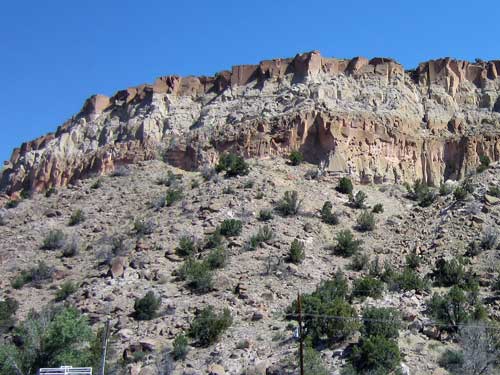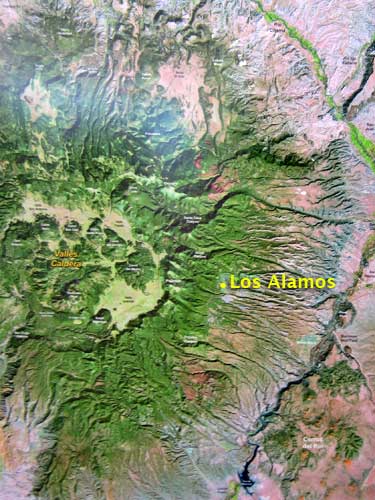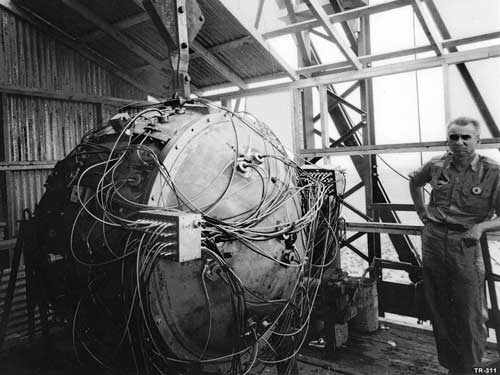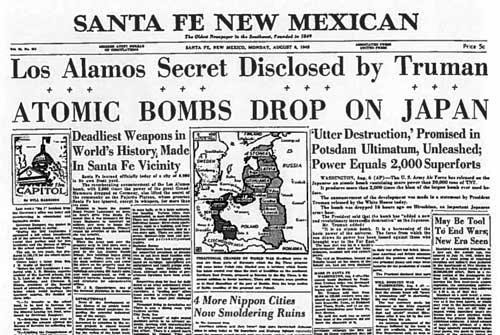LOS ALAMOS & SANTA FE (Day 3 - part 1)
Our hotel room did a wonderful job conveying the feeling of Santa Fe.




Again we enjoyed a huge breakfast... apple-filled pancakes, fried potatoes with salsa, yogurt, cereal and granola, fruit, muffins, self-made waffles, etc.

So much to choose from!

Our view next to the indoor pool
We set off on a lovely scenic drove for Los Alamos.
The stretch of highway 285 between Santa Fe and Pojoaque is covered with pueblo symbols and colorful southwestern patterns on its overpasses, noise abatement and retaining walls in an attempt to enhance the road's aesthetic quality. It's the most extensive roadside art project ever undertaken in New Mexico. Thanks to artists Frederico Vigil, Anthony Dorame and George Rivera, we get to enjoy corn dancers, horny toads, deer, snakes, and other symbols of the area.

K'uuyemugeh is the Tewa name for the community of Cuyamungue.
Tewa is one of five Tanoan languages spoken by the Pueblo people of New Mexico. Although the languages are closely related, the speaker of one language can not fully understand the other languages (similar to German and Dutch). The groups includes the Nambe, Pojoaque, San Ildefonso, Ohkay Owingeh, Santa Clara, and Tesuque Pueblos.

The short-horned lizard is known as a horned toad or horny toad.

As soon as we enter the reservation,...

... casinos begin to appear.

The Cities of Gold in Pojoaque was the first casino to open in northern New Mexico in the mid-1990's.
We turned onto Highway 502 headed toward Los Alamos. The views and rock formations were lovely!







Our destination
Our first stop was the visitor center, where we learned all about the town and what there was to see and do.

The super helpful visitor center

To early map makers, this great circle of mountains was merely an oddly connected series of valleys. It wasn't until the 1920's that it was realized to be the rim of an ancient and extinct volcano. The Native American name of "Jemez" means "place of boiling springs." The giant crater is actually a caldera, the huge saucer left after a volcano collapses upon itself after having spewed all its insides out. The surrounding peaks are the result of secondary upthrusts.

The town sits on a series of finger-like mesa tops
Various peoples and tribes existed here for hundreds of years before the first settlers showed up in 1891. They were farmers, ranchers and homesteaders who lived on the mesa tops, but heavy snows drove them away every winter. The first permanent settlers built log cabins around 1911. Homesteader Harold Hemingway Brook and a lumberjack named Mack Hooper named their land Alamos Ranch. It was purchased by Ashley Pond in 1917 who turned it into a boys' ranch school. In 1942, however, school officials received a letter that the War Department was taking over their property... and the secret town of Los Alamos (the Atomic City) was born.

The last days of the Los Alamos Ranch School

Items for sale in the visitor center

Albert Einstein (1879 -1955), the unwilling father of the atomic bomb
"The unleashed power of the atom has changed everything save our modes of thinking and we thus drift toward unparalleled catastrophe". (1946)
"Had I known that the Germans would not succeed in producing an atomic bomb, I would not have lifted a finger". (1947)

Gotta love science geek humor
Our first stop was the Bradbury Science Museum... with free admission!! The museum tells the story of the Los Alamos National Laboratory and the race to build the first atomic bomb during the Manhattan Project. It also covers current science and technology including nanotechnology, biofuels, radiation, environmental research and has more than 60 interactive exhibits.

The idea began in 1953, when Robert Krohn, who had worked at the Laboratory, suggested a museum to preserve its history and numerous artifacts. Norris Bradbury (who was the Laboratory's second director from 1945 - 1970) agreed. At first an old ice house was used since it had the security to protect the classified exhibits. Unclassified materials were eventually added, and in 1963 the museum was transferred to a more public location. As the collection continued to grow, the museum was moved yet again. Finally in 1993, it found its home in its current location.

Norris Edwin Bradbury (1909 - 1997)

Bradbury (left) worked closely with with Robert Oppenheimer on the Manhattan Project. (photo from 1964)
We first watched a movie called "The town that never was" about the history of Los Alamos, then explored the different areas of the museum.
Nuclear fission was discovered in Germany in 1938 by Otto Hahn, along with Austrian physicist Lise Meitner and an assistant Friedrich Wilhelm "Fritz" Strassmann. Later that year, Meitner had to flee Nazi Germany due to Jewish persecutions and eventually escaped to Sweden. Her nephew, Austrian-born Otto Robert Frisch, had already moved to London in 1933 when Adolf Hitler began to come into power. They continued their research together and wrote a paper explaining the physics behind the phenomenon. In 1940, Frisch along with German-born Rudolf Peierls wrote a paper on how one could construct an atomic bomb. Fearing the Nazis would make one first, the US government amped up atomic research. Scientists, such as Italian-born Enrico Fermi, were fleeing Europe in droves. Fermi was one of the few physicists to excel both theoretically and experimentally. He would end up creating the world's first nuclear reactor, the Chicago Pile-1, in 1942.

Otto Hahn (1879 - 1968), Otto Robert Frisch (1904 - 1979), Sir Rudolf Ernst Peierls (1907 - 1995) and Enrico Fermi (1901 - 1954)

Lise Meitner (1878 - 1968) and Otto Hahn, 1913
In August 1939, Albert Einstein had delivered a letter to President Franklin D. Roosevelt warning of the potential development of "extremely powerful bombs of a new type." A defense committee was formed and the atomic program was born. To control it, Roosevelt chose the army to run it. Their Corps of Engineers Construction Division was located in the district of Manhattan, New York. While the project was officially named "Development of Substitute Materials", it was common practice at the time to call a project after the name of the area where it was located... hence the Manhattan Project.
At first, this was a joint effort involving many locations and universities, but secret communication quickly became too difficult and ineffective. It was decided that just one primary site was needed... Project Y.

Important sites of the Manhattan Project: Fermi's nuclear reactor was built at the University of Chicago; plants at Oak Ridge (Tennessee) and Hanford (Washington) produced nuclear materials; uranium ore came from mines in Canada and Africa; universities provided research, etc.
Theoretical physicist J. Robert Oppenheimer of the University of California, Berkeley, who was already involved with the project, was familiar with this area from his younger days. It had all the requirements a secret city would need: it was inland (good for security purposes); it had good climate year round (good for outdoor testing); and it was accessible by road and train but was still sparsely populated.
So in 1942, the War Department took over the Los Alamos Ranch School and kicked everyone out of the area. Construction crews moved in and a town was hastily built that resembled more of a frontier mining camp, surrounded by a high barbed wire fence and armed guards. Starting in the spring of 1943, scientists from all over the world began arriving in Santa Fe and then 'disappearing' into "the hill" located at the end of a torturous, winding dirt road. They couldn't tell their family or friends where they were going or what they were doing. Mail was censored and even sent back as 'inappropriate.' The city didn't have a name but was merely known as PO Box 1663. Scientists were often given id cards with false names or just numbers. Enrico Fermi became Henry Farmer and Neils Bohr was Nicholas Baker. No one used the word physicist; everyone was just an 'engineer.' Administrative personnel and technicians were expected to accept jobs in an unknown place for an unknown purpose.



Julius Robert Oppenheimer (1904 - 1967) and Lieutenant General Leslie Richard Groves Jr. (1896 - 1970), who oversaw the construction of and directed the Manhattan Project. (photo from 1945)

A 1964 meeting, with Norris Bradbury, John Manley, Enrico Fermi and J.M.B. Kellogg in the first row and Robert Oppenheimer and Richard Feynman in the second row.

Richard Phillips Feynman (1918 - 1988) was an American theoretical physicist. He was also a highly interesting and entertaining character. One of his more memorable adventures was documented by Ralph Leighton in the book "Tuva or Bust!: Richard Feynman's Last Journey."
After just one year of opening, the Laboratory was ready to build two types of bombs... plutonium and uranium. They were confident the uranium gun bomb would work, but the plutonium implosion bomb needed to be tested.
The first nuclear weapon was tested on July 16, 1945. Given the codename Trinity, the test was conducted on what is now part of White Sands Missile Range.The device was nicknamed "The Gadget." It would produce an explosion equivalent to 20,000 tons of TNT.

Bradbury was in charge of the final assembly of The Gadget

It left a crater 5 feet deep and 30 feet wide.

During development of the bomb, plutonium was still being produced in limited quantities. A steel containment vessel called Jumbo was built so that should the bomb fail, the plutonium could be recovered. By the time things were ready to go, Oppenheimer felt ample plutonium was being produced that there would be enough for a second test, if needed. Besides, the container would interfere with the gathering of data on the explosion, a primary objective of the test. Therefore Jumbo wasn't used.

Groves and Oppenheimer at the remains of the Trinity tower a few weeks later
The Trinity Gadget (officially a Y-1561 device) was promptly altered to fit in an airplane. A few weeks later, on August 6, the US dropped a uranium gun-type atomic bomb (Little Boy) on Hiroshima, Japan. Three days later, it dropped a plutonium implosion-type bomb like the Trinity Gadget (Fat Man) on Nagasaki. Within the first couple months, up to 146,000 people died in Hiroshima and up to 80,000 died in Nagasaki (roughly half of the deaths occurred on the first day). During the following months, many more people died from burns, radiation sickness, injuries, illness and malnutrition.

Atomic bomb mushroom clouds over Nagasaki

On August 15, Japan announced its surrender. That, combined with the unconditional surrender of German forces back on May 8, marked the end of World War II. Now that the threat was over, scientists began leaving Los Alamos. Bradbury, however, stayed on as director (taking over from Oppenheimer). It was a struggle but he managed to keep the Laboratory open. He hoped to find peacetime applications and start a scientific revolution.

There were several walls filled with stories.

Connie Fulgenzi came with five other young women to work in the Pass & Badge Office. "My first impression of Los Alamos was awful; I thought it looked like a mining camp. In fact, many of the girls I cam up with left immediately, but I stuck it out."

Arthur Hemmendinger was a physicist working at the University of Chicago when he got word of help needed at the Lab. "You could get housing if you were married, so I went out and got a wife. It was not an easy life in the early days of Los Alamos. We not only ran out of hot water but we ran out of water period."

Carmen Geoffrion worked as a clerk in the post office. She had come up to the Hill with her father who was an accountant. "When I asked what was being made here, the answer was 'We are building windshield wipers for submarines.' I really had no idea what was going on at Los alamos until after the bomb went off at Hiroshima."

Benjamin Diven was one of the first physicists to arrive. "There was just this terrible big cloud of dust on The HIll at that time, and I was just a handyman because nothing was completed."

Jean Waiter was an electronics technician in the Women's Army Corp. She met her husband, Winston Dabney, here... although it took them three attempts before they actually met for a date due to work related issues.

Roger Rasmussen was drafted into the army in 1943 and eventually sent up here to build diagnostic equipment. In the army mess tent, "Often the lights would go out while we were eating. Everyone would stop eating until the lights went back on. This was because there were cockroaches and you didn't want to mistake the cockroach for the food on your plate. Actually, the roaches would make off with your meal."
return • continue

